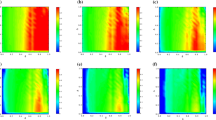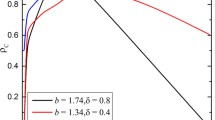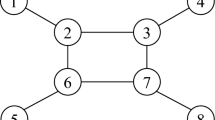Abstract
We present a computational model which mainly concentrates on the effect of adjusting the signal strength of game from an agent to its a neighbor by considering the information quantity in individual’s database to study the evolutionary prisoner’s dilemma game on directed-weighted square lattices. In this model, each agent considers the current and historical payoff both obtained from the same neighbor, and regulates the strength of sending signal according to these information. More specifically, for paired agents x and y in network, x will increase the signal strength from it to y in case of it obtains current income higher than the historical payoff; conversely, x will reduce the signal strength because its current income less than the historical one. The simulation results show that this evolutionary rule not only can help cooperators get out of danger of extinction, but also can hugely boost the cooperation in population. Interestingly, for a fixed cost–benefit ratio r (\(0<r<0.246\)), there exists the minimal information quantity, resulting in the higher cooperation level (even can reach the status of full cooperation) due to the positive feedback effect in system. Besides, by a modified pair, approximation method qualitatively verifies the role of adjusting signal strength according to the information quantity on cooperation. We also explore the reason of emergence and persistence of cooperation by a few representative snapshots in system. Our results may enhance the understanding of evolutionary dynamics with stochastic interaction in graph-structured populations.









Similar content being viewed by others
References
Hauert, C., Szabó, G.: Game theory and physics. Am. J. Phys. 73(5), 405–414 (2005)
Shigaki, K., Tanimoto, J., Wang, Z., Kokubo, S., et al.: Referring to the social performance promotes cooperation in spatial Prisoner’s Dilemma games. Phys. Rev. E 86(3), 031141 (2012)
Christakis, N.A., Fowler, J.H.: Friendship and natural selection. Proc. Natl. Acad. Sci. USA 111(3), 10796–10801 (2014)
Liu, L.J., Chen, X.J., Perc, M.: Evolutionary dynamics of cooperation in the public goods game with pool exclusion strategies. Nonlinear Dyn. 97(1), 749–766 (2019)
Li, J.Q., Zhang, C.Y., Sun, Q.L., Chen, Z.Q.: Changing intensity of interaction can resolve prisoner’s dilemmas. EPL 113(5), 58002 (2016)
Zhang, J.L., Chen, Z.Q., Liu, Z.X.: Fostering cooperation of selfish agents through public goods in relation to the loners. Phys. Rev. E 93(3), 032320 (2016)
Zhang, J.L., Xu, Z.M., Chen, Z.Q.: Effects of strategy switching and network topology on decision-making in multi-agent systems. Int. J. Syst. Sci 49(9), 1934–1949 (2018)
Shi, L., Shen, C., Geng, Y.N., et al.: Winner-weaken-loser-strengthen rule leads to optimally cooperative interdependent networks. Nonlinear Dyn. 96(1), 49–56 (2019)
Wang, Z., Kokubo, S., Jusup, M., Tanimoto, J.: Universal scaling for the dilemma strength in evolutionary games. Phys. Life Rev. 14, 1–30 (2015)
Zhang, C.Y., Liu, Z.X., Sun, Q.L.: Altruism in multiplayer snowdrift games with threshold and punishment. EPL 111(5), 58004 (2015)
Chen, W., Wu, T., Li, Z.W., Wang, L.: Friendship-based partner switching promotes cooperation in heterogeneous populations. Physica A 443, 192–199 (2016)
Zhang, J.L., Weissing, F.J., Cao, M.: Fixation of competing strategies when interacting agents differ in the time scale of strategy updating. Phys. Rev. E 94(3), 032407 (2016)
Li, J.Q., Dang, J.W., Zhang, J.W.: Length of information-based bidirectional choice in spatial prisoner’s dilemma. Appl. Math. Comput. 369, 124837 (2020)
Voelkl, B.: The evolution of generalized reciprocity in social interaction networks. Theor. Popul. Biol. 104, 17–25 (2015)
Quek, H.-Y., Tan, K.C., Goh, C.-K., Abbass, H.A.: Evolution and incremental learning in the iterated prisoner’s dilemma. IEEE Trans. Evol. Comput. 13(2), 303–320 (2009)
Cong, R., Wu, T., Qiu, Y.Y., Wang, L.: Time scales in evolutionary game on adaptive networks. Phys. Lett. A 378(13), 950–955 (2014)
Xiao, Y.P., Chen, D.Q., et al.: Rumor propagation dynamic model based on evolutionary game and anti-rumor. Nonlinear Dyn. 95(1), 523–539 (2019)
Nowak, M.A., May, R.M.: Evolutionary games and spatial chaos. Nature 359, 826–829 (1992)
Rong, Z.H., Wu, Z.X., Chen, G.R.: Coevolution of strategy-selection time scale and cooperation in spatial prisoner’s dilemma game. EPL 102(6), 68005 (2013)
Nowak, M.A.: Five rules for the evolution of cooperation. Science 314(5805), 1560–1563 (2006)
Szabó, G., Fath, G.: Evolutionary games on graphs. Phys. Rep. 446(4), 97–216 (2007)
Zhang, J.L., Zhang, C.Y., Cao, M.: How insurance affects altruistic provision in threshold public goods games. Sci. Rep. 5, 9098 (2015)
Tanimoto, J.: Simultaneously selecting appropriate partners for gaming and strategy adaptation to enhance network reciprocity in the prisoner’s dilemma. Phys. Rev. E 89(1), 012106 (2014)
Santos, F.C., Pacheco, M.: Scale-free networks provide a unifying framework for the emergence of cooperation. Phys. Rev. Lett. 95(9), 098104 (2005)
Santos, F.C., Pacheco, J.M.: Evolutionary dynamics of social dilemmas in structured heterogeneous populations. Proc. Natl. Acad. Sci. USA 103(9), 3490–3494 (2006)
Ohtsuki, H., Nowak, M.A., Pacheco, J.M.: Breaking the symmetry between interaction and replacement in evolutionary dynamics on graphs. Phys. Rev. Lett. 98(10), 108106 (2007)
Rong, Z.H., Wu, Z.X., Wang, W.X.: Emergence of cooperation through coevolving time scale in spatial prisoner’s dilemma. Phys. Rev. E 82(2), 026101 (2010)
Wang, Z., Perc, M.: Aspiring to the fittest and promotion of cooperation in the prisoner’s dilemma game. Phys. Rev. E 82(2), 021115 (2010)
Chen, X.J., Wang, L.: Cooperation enhanced by moderate tolerance ranges in myopically selective interactions. Phys. Rev. E 80(4), 046109 (2009)
Perc, M., Szolnoki, A.: A double-edged sword: benefits and pitfalls of heterogeneous punishment in evolutionary inspection games. Sci. Rep. 5, 11027 (2015)
Szolnoki, A., Perc, M.: Coevolution of teaching activity promotes cooperation. New J. Phys. 10, 043036 (2008)
Chong, S.Y., Yao, X.: Behavioral diversity, choices and noise in the iterated prisoner’s dilemma. IEEE Trans. Evol. Comput. 9(6), 540–551 (2005)
Chen, Y.Z., Huang, Z.G., Wang, S.J., et al.: Diversity of rationality affects the evolution of cooperation. Phys. Rev. E 79(5), 055101 (2009)
Liu, Y.K., Chen, X.J., Zhang, L., et al.: Win-stay-lose-learn promotes cooperation in the spatial Prisoner’s dilemma game. PLoS ONE 7(2), e30689 (2012)
Szolnoki, A., Perc, M.: Emergence of multilevel selection in the prisoner’s dilemma game on coevolving random networks. New J. Phys. 11, 093033 (2009)
Perc, M.: Double resonance in cooperation induced by noise and network variation for an evolutionary prisoner’s dilemma. New J. Phys. 8, 183 (2006)
Perc, M., Szolnoki, A.: Coevolutionary games–a mini review. BioSystems 99(2), 109–125 (2010)
Szolnoki, A., Perc, M., Danku, Z.: Making new connections towards cooperation in the prisoner’s dilemma game. EPL 84(5), 50007 (2008)
Li, J.Q., Zhang, C.Y., Sun, Q.L., Chen, Z.Q.: Coevolution between strategy and social networks structure promotes cooperation. Chaos Soliton Fract 77, 253–263 (2015)
Zimmermann, M.G., Eguiluz, V.M., San Miguel, M.: Coevolution of dynamical states and interactions in dynamic networks. Phys. Rev. E 69(6), 065102 (2004)
Szolnoki, A., Perc, M.: Resolving social dilemmas on evolving random networks. EPL 86(3), 30007 (2009)
Fu, F., Hauert, C., Nowak, M.A., Wang, L.: Reputation-based partner choice promotes cooperation in social networks. Phys. Rev. E 78(2), 026117 (2008)
Pacheco, J.M., Traulsen, A., Nowak, M.A.: Coevolution of strategy and structure in complex networks with dynamical linking. Phys. Rev. Lett. 97, 258103 (2006)
Wang, J., Suri, S., Watts, D.J.: Cooperation and assortativity with dynamic partner updating. Proc. Natl. Acad. Sci. USA 109(36), 14363–14368 (2012)
Fehl, K., van der Post, D.J., Semmann, D.: Coevolution of behaviour and social network structure promotes human cooperation. Ecol. Lett. 14(6), 546–551 (2011)
Yang, H.X., Wu, Z.X., Wang, B.H.: Role of aspiration-induced migration in cooperation. Phys. Rev. E 81(6), 065101 (2010)
Li, Y., Ye, H., Zhang, H.: Evolution of cooperation driven by social-welfare-based migration. Physica A 445, 48–56 (2016)
Wang, W.X., Yang, R., Lai, Y.C.: Cascade of elimination and emergence of pure cooperation in coevolutionary games on networks. Phys. Rev. E 81(3), 035102 (2010)
Wang, Z., Wang, L., Szolnoki, A., Perc, M.: Evolutionary games on multilayer networks: a colloquium. Eur. Phys. J. B 88(5), 124 (2015)
Xia, C.Y., Meng, X.K., Wang, Z.: Heterogeneous coupling between interdependent lattices promotes the cooperation in the Prisoner’s dilemma game. PLoS ONE 10(6), e0129542 (2015)
Wang, Z., Szolnoki, A., Perc, M.: Rewarding evolutionary fitness with links between populations promotes cooperation. J. Theor. Biol. 349, 50–56 (2014)
Wang, Z., Wang, L., Perc, M.: Degree mixing in multilayer networks impedes the evolution of cooperation. Phys. Rev. E 89(5), 052813 (2014)
Traulsen, A., Nowak, M.A., Pacheco, J.M.: Stochastic payoff evaluation increases the temperature of selection. J. Theor. Biol. 244(2), 349–356 (2007)
Chen, X.J., Fu, F., Wang, L.: Interaction stochasticity supports cooperation in spatial Prisoner’s dilemma. Phys. Rev. E 78(5), 051120 (2008)
Li, J.Q., Zhang, C.Y., Sun, Q.L., Chen, Z.Q., Zhang, J.L.: Changing the intensity of interaction based on individual behavior in the iterated Prisoner’s dilemma game. IEEE Trans. Evol. Comput. 21(4), 506–517 (2017)
Tanimoto, J., Sagara, H.: Relationship between dilemma occurrence and the existence of a weakly dominant strategy in a two-player symmetric game. BioSystems 90(1), 105–114 (2007)
Szabó, G., Toke, C.: Evolutionary Prisoner’s dilemma game on a square lattice. Phys. Rev. E 58(1), 69–73 (1998)
Li, Z., Yang, Z., Wu, T., Wang, L.: Aspiration-based partner switching boosts cooperation in social dilemmas. PLoS ONE 9, e97866 (2014)
Hauert, C., Doebeli, M.: Spatial structure often inhibits the evolution of cooperation in the snowdrift game. Nature 428(6983), 643–646 (2004)
Xia, C.Y., Wang, L., Sun, S.W., Wang, J.: An SIR model with infection delay and propagation vector in complex networks. Nonlinear Dyn. 69(3), 927–934 (2012)
Xu, X.L., Chen, Z.Q., Si, G.Y., Hu, X.F., Jiang, Y.Q., Xu, X.S.: The chaotic dynamics of the social behavior selection networks in crowd simulation. Nonlinear Dyn. 64(1), 117–126 (2011)
Acknowledgements
This research is supported by National Natural Science Foundation of China (No.61963013) and Innovation Capacity Improvement Project of the Education Department of Gansu Province (2019A-107).
Author information
Authors and Affiliations
Corresponding authors
Ethics declarations
Conflicts of interest
The authors declare that they have no conflict of interest concerning the publication of this paper.
Additional information
Publisher's Note
Springer Nature remains neutral with regard to jurisdictional claims in published maps and institutional affiliations.
Rights and permissions
About this article
Cite this article
Li, J., Park, J.H., Zhang, J. et al. The networked cooperative dynamics of adjusting signal strength based on information quantity. Nonlinear Dyn 100, 831–847 (2020). https://doi.org/10.1007/s11071-020-05544-3
Received:
Accepted:
Published:
Issue Date:
DOI: https://doi.org/10.1007/s11071-020-05544-3




